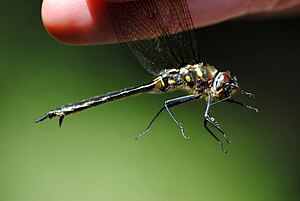Somatochlora minor
| Somatochlora minor | ||||||||||||
|---|---|---|---|---|---|---|---|---|---|---|---|---|

"" Somatochlora minor "in Piscataquis County , Maine |
||||||||||||
| Systematics | ||||||||||||
|
||||||||||||
| Scientific name | ||||||||||||
| Somatochlora minor | ||||||||||||
| Calvert , 1898 |
Somatochlora minor is a type of dragonfly from the family of falcon dragonflies (Corduliidae), which belong to the large dragonflies (Anisoptera). The species is particularly common in the northern United States and Canada . It flies between June and August.
features
Construction of the Imago
The blackish Imago of Somatochlora minor measures 42-50 mm, of which 29 to 38 millimeters on the abdomen ( abdominal omitted), which is relatively small within the genus. In terms of color, the abdomen, as usual in the genus, is dark and shiny green and has a yellow pattern. This consists of a patch on the auricles and another on the top of the second segment . The spots which in the females develop so far that they form a larger sickle-shaped structure. On the third segment there is an upper and a lower triangle on the sides.
Thin hairs occupy the greenish pterothorax . They are longer at the front and shorter at the back. The stripes on the chest that are typical of the genus have become two round dots. The 30 to 34 millimeter long wings are transparent. Only the anal triangle is golden yellow at the base in the males. The legs are, except for the yellow front of the femurs of the front and middle pair of legs, black.
In the black face there is a crescent-shaped yellow spot on the anteclypeus . There are two more round spots on the two sides of the forehead ( frons ), which is metallic green on top . Also metallic green is the vertex ( vertex ). The last yellow spot is at the rear edge of the complex eye . There are also gray hairs on the back of the head ( occiput ) and on the back of the head, the edge of which also has a hem of longer hairs.
Construction of the larva
The brown larva measures between 21 and 22.5 millimeters and is eight to nine millimeters wide at the widest point, the sixth to seventh segment. Dorsal hooks can be found on segments four with nine and become more and more pronounced towards the rear. Lateral thorns are found on the eighth and ninth segments. The hind wing sheath extends to the middle of the sixth segment.
The femora of the posterior pair of legs measure 6.75 to 7 millimeters, the posterior tibia measures 8 to 8.4 millimeters.
The six millimeter wide head is roughly twice as long. The sides of the head merge obliquely into the slightly concave occiput. In contrast to the rest of the larva, this transition is hairy and long. The antennae are also hairy , with the hair decreasing away from the body. Both the mentum and the lower lip ( labium ) extend to the mesothorax . There are eleven to thirteen hairs on the Mentum, which is roughly as long as it is wide.
Way of life
Young animals of both sexes have been observed along or within pine forests up to a mile from the breeding waters. These are smaller rivers that flow through bushes or forests, but are not completely shaded by them. The males fly almost a foot above the water surface and sometimes stay in the air for a long time. The females lay their eggs on mossy banks in the river. To do this, touch a water-covered area of the bench with the tip of the abdomen.
Individual evidence
- ↑ a b James George Needham , Minter Jackson Westfall , Michael L. May : Dragonflies of North America ISBN 0-945417-94-2
- ^ A b Edmund Murton Walker : The North American dragonflies of the genus Somatochlora in University of Toronto studies 26